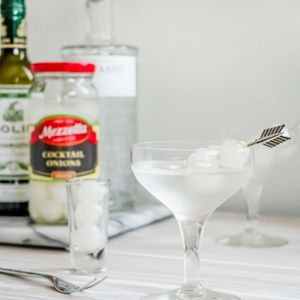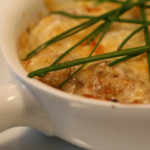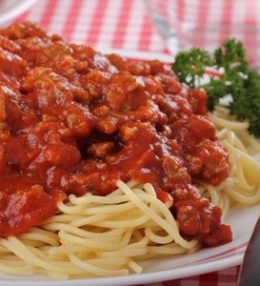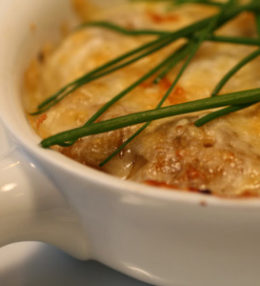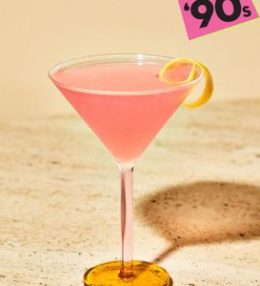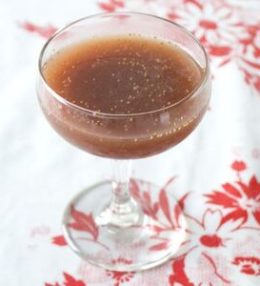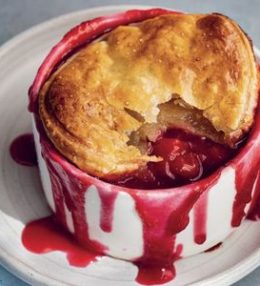
I don’t know when in my life the onion transitioned from something I just chopped up for cooking into one of my favorite cocktail garnishes. But it’s true, I love a pickled onion—even more so when it’s swimming in my Martini. While the olive and the lemon peel usually get first pick when it comes to garnishing a Martini, adding a cocktail onion (or 3!!) will transform your classic drink into what is also known as the Gibson Cocktail.
Simply Recipes / Elana Lepkowski
Gibson Cocktail Origins: Multiple Stories
Why does this simple variation on a classic Martini get its own name? Well, in the late 19th century in San Francisco…sorry. Unfortunately, that’s where the trail for the cocktail’s history dies off.
There are multiple origin stories: all with gentlemen named Gibson, all trying to improve upon their Martini cocktail, and not a single one for which we have definitive, verifiable proof of authenticity.
You can find a reference for a Gibson in the 1908 cocktail book “The World’s Drinks and How to Mix Them,” but it does not include any garnish, and is closer to 50/50 Martini (half gin and half vermouth). The cocktail onion as a garnish starts to appear on menus somewhere between the 1930s and ‘40s, and after that we’ve got the Gibson Martini as we know it today.
A Classic Gin Martini is the Base for a Gibson
The Gibson can be made just as you make your own classic gin Martini. However, if you don’t already have a favorite Martini recipe and technique, I’ll share mine here. As with a classic Martini, a Gibson is traditionally made with gin (although if you’re a strict vodka Martini drinker, feel free to sub that in here), specifically a London Dry style gin that has an emphasis on the juniper flavor profile. If you stray outside of this style, you’ll need to make sure it will work with the pungent briny pickled onion flavor.
I prefer Ford’s gin for this, but if that’s not available where you are, Beefeater is another solid choice.
Next up is a dry style vermouth. Noilly Prat and Dolin both produce a dry, slightly sweet and bitter French vermouth that enhances the flavor of the gin and onion without overpowering the whole drink.
Simply Recipes / Elana Lepkowski
A Pickled Onion Garnish? Yes!
Finally, we come to the pickled onion itself. If you pickle your own, absolutely reach for one of those (I will when I have them). If you’re looking for store-bought, Mezzetta can be found at many larger liquor stores, and I use those here in this recipe.
Local grocery stores may also carry a variety of brands to choose from as well. Just keep this in mind: although it’s considered a “garnish”, the flavor of the onion will most assuredly carry its flavor into your drink. So, if it’s not something you’d consider popping into your mouth to eat when your drink is done, you probably don’t want it sitting in your Martini. Buy something only if you’d eat it!
A Martini Should Be Stirred, Not Shaken
Once you’ve got all your ingredients, grab your mixing glass, not a shaker (a pint glass works well). A Martini should be stirred, not shaken. I’ve been taught by many bartenders that the trick to remembering this is that any drink that is all alcohols should be stirred.
Save your shaking for drinks that include juice and/or egg whites. When you’re ready to serve, spear a few cocktail onions on a pick and drop that into a coupe (or a “Martini” glass if you’ve got one in your cupboard).
Simply Recipes / Elana Lepkowski
Make These Classic Cocktails
- Manhattan Cocktail
- French Martini
- Gin Fizz
- Mezcal Mule
- Tom Collins
-
2 ounces London Dry style gin
-
3/4 ounce dry vermouth
-
2-3 pickled cocktail onions, for garnish
-
Make the cocktail:
In a mixing glass 2/3 filled with ice, pour in the gin and vermouth. Stir with a mixing spoon or chopstick for 20 seconds. Strain into a coupe or Martini glass.
Simply Recipes / Elana Lepkowski
-
Garnish and serve:
Garnish with 2-3 pickled onions that have been speared on a cocktail pick. Serve.
Did you love the recipe? Leave us stars below!
Simply Recipes / Elana Lepkowski
Simply Recipes / Elana Lepkowski
| Nutrition Facts (per serving) | |
|---|---|
| 162 | Calories |
| 0g | Fat |
| 3g | Carbs |
| 0g | Protein |
×
| Nutrition Facts | |
|---|---|
| Servings: 1 | |
| Amount per serving | |
| Calories | 162 |
| % Daily Value* | |
| 0g | 0% |
| Saturated Fat 0g | 0% |
| 0mg | 0% |
| 7mg | 0% |
| 3g | 1% |
| Dietary Fiber 0g | 0% |
| Total Sugars 0g | |
| 0g | |
| Vitamin C 0mg | 0% |
| Calcium 2mg | 0% |
| Iron 0mg | 0% |
| Potassium 22mg | 0% |
| *The % Daily Value (DV) tells you how much a nutrient in a food serving contributes to a daily diet. 2,000 calories a day is used for general nutrition advice. | |
Nutrition information is calculated using an ingredient database and should be considered an estimate. In cases where multiple ingredient alternatives are given, the first listed is calculated for nutrition. Garnishes and optional ingredients are not included.
I don’t know when in my life the onion transitioned from something I just chopped up for cooking into one of my favorite cocktail garnishes. But it’s true, I love a pickled onion—even more so when it’s swimming in my Martini. While the olive and the lemon peel usually get first pick when it comes to garnishing a Martini, adding a cocktail onion (or 3!!) will transform your classic drink into what is also known as the Gibson Cocktail. Simply Recipes / Elana Lepkowski Gibson Cocktail Origins: Multiple Stories Why does this simple variation on a classic Martini get its own name? Well, in the late 19th century in San Francisco…sorry. Unfortunately, that’s where the trail for the cocktail’s history dies off. There are multiple origin stories: all with gentlemen named Gibson, all trying to improve upon their Martini cocktail, and not a single one for which we have definitive, verifiable proof of authenticity. You can find a reference for a Gibson in the 1908 cocktail book “The World’s Drinks and How to Mix Them,” but it does not include any garnish, and is closer to 50/50 Martini (half gin and half vermouth). The cocktail onion as a garnish starts to appear on menus somewhere between the 1930s and ‘40s, and after that we’ve got the Gibson Martini as we know it today. A Classic Gin Martini is the Base for a Gibson The Gibson can be made just as you make your own classic gin Martini. However, if you don’t already have a favorite Martini recipe and technique, I’ll share mine here. As with a classic Martini, a Gibson is traditionally made with gin (although if you’re a strict vodka Martini drinker, feel free to sub that in here), specifically a London Dry style gin that has an emphasis on the juniper flavor profile. If you stray outside of this style, you’ll need to make sure it will work with the pungent briny pickled onion flavor. I prefer Ford’s gin for this, but if that’s not available where you are, Beefeater is another solid choice. Next up is a dry style vermouth. Noilly Prat and Dolin both produce a dry, slightly sweet and bitter French vermouth that enhances the flavor of the gin and onion without overpowering the whole drink. Simply Recipes / Elana Lepkowski A Pickled Onion Garnish? Yes! Finally, we come to the pickled onion itself. If you pickle your own, absolutely reach for one of those (I will when I have them). If you’re looking for store-bought, Mezzetta can be found at many larger liquor stores, and I use those here in this recipe. Local grocery stores may also carry a variety of brands to choose from as well. Just keep this in mind: although it’s considered a “garnish”, the flavor of the onion will most assuredly carry its flavor into your drink. So, if it’s not something you’d consider popping into your mouth to eat when your drink is done, you probably don’t want it sitting in your Martini. Buy something only if you’d eat it! A Martini Should Be Stirred, Not Shaken Once you’ve got all your ingredients, grab your mixing glass, not a shaker (a pint glass works well). A Martini should be stirred, not shaken. I’ve been taught by many bartenders that the trick to remembering this is that any drink that is all alcohols should be stirred. Save your shaking for drinks that include juice and/or egg whites. When you’re ready to serve, spear a few cocktail onions on a pick and drop that into a coupe (or a “Martini” glass if you’ve got one in your cupboard). Simply Recipes / Elana Lepkowski Make These Classic Cocktails Manhattan Cocktail French Martini Gin Fizz Mezcal Mule Tom Collins 2 ounces London Dry style gin 3/4 ounce dry vermouth 2-3 pickled cocktail onions, for garnish Make the cocktail: In a mixing glass 2/3 filled with ice, pour in the gin and vermouth. Stir with a mixing spoon or chopstick for 20 seconds. Strain into a coupe or Martini glass. Simply Recipes / Elana Lepkowski Garnish and serve: Garnish with 2-3 pickled onions that have been speared on a cocktail pick. Serve. Did you love the recipe? Leave us stars below! Simply Recipes / Elana Lepkowski Simply Recipes / Elana Lepkowski Nutrition Facts (per serving) 162 Calories 0g Fat 3g Carbs 0g Protein × Nutrition Facts Servings: 1 Amount per serving Calories 162 % Daily Value* 0g 0% Saturated Fat 0g 0% 0mg 0% 7mg 0% 3g 1% Dietary Fiber 0g 0% Total Sugars 0g 0g Vitamin C 0mg 0% Calcium 2mg 0% Iron 0mg 0% Potassium 22mg 0% *The % Daily Value (DV) tells you how much a nutrient in a food serving contributes to a daily diet. 2,000 calories a day is used for general nutrition advice. Nutrition information is calculated using an ingredient database and should be considered an estimate. In cases where multiple ingredient alternatives are given, the first listed is calculated for nutrition. Garnishes and optional ingredients are not included.
Gibson Cocktail


